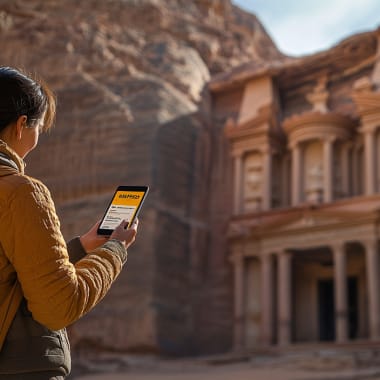
Best historical sites in Jordan
From rock cities to Roman ruins – discover the most fascinating testimonies of Jordanian history.
From rock cities to Roman ruins – discover the most fascinating testimonies of Jordanian history.
Jordan is a country where the past and present merge in impressive ways. For millennia, it has been a crossroads of great cultures and empires – from the Nabataeans to the Romans and the Islamic Golden Age. For individual travelers who wish to experience history up close, the kingdom offers a variety of outstanding sites that impress not only with their architecture but also with their atmosphere. In this article, we present to you the six most significant historical sites in Jordan – perfect for those who want to dive deep into the stories of this fascinating land.
Petra
The legendary rock city – Jordan's most spectacular cultural heritage amid reddish canyons
A place that breathes history
Petra was presumably founded in the 6th century BC by the Nabataeans – an Arab people who settled in the area of present-day Jordan. Over time, the city developed into the capital of the Nabataean Kingdom and played a central role in the politics and economy of the region. The Nabataeans were not only skilled traders but also brilliant builders, transforming Petra into a significant center of long-distance trade.
As a hub of important trade routes between Egypt, Syria, Arabia, and the Mediterranean, Petra particularly controlled the so-called Incense Route. Through it, luxury goods such as incense, spices, and silk were transported – the foundation for the city's wealth. This richness allowed for the construction of monumental buildings that are still preserved today.
Petra experienced its heyday in the 1st century BC and 1st century AD, with an estimated population of 40,000. Even after its incorporation into the Roman Empire in 106 AD, Petra remained an important trading center but gradually lost significance – not least due to natural disasters such as earthquakes. Today, the rock city is considered a masterpiece of ancient architecture and a symbol of Nabataean culture. In 1985, Petra was declared a UNESCO World Heritage Site and has since become one of the most impressive attractions in the Middle East.
What you can discover on-site
A visit to Petra is like a journey to another time. The archaeological site spans several square kilometers and offers numerous highlights:
- The Treasury (Al-Khazneh):
The most famous structure in Petra is nearly 40 meters high and was intricately carved into the reddish rock in Hellenistic style – a spectacular sight, especially in the morning. - The Royal Tombs along the King's Wall:
Several ornate tombs, including the Urn Tomb, the Palace Tomb, and the Corinthian Tomb, line an imposing rock wall. - The Monastery (Ad Deir):
After a demanding ascent, the monastery rewards visitors with its massive facade and an impressive panoramic view of the surrounding area. - The Siq:
The narrow, approximately 1.2-kilometer-long gorge is the dramatic entrance to the rock city – an unforgettable experience. - Viewpoints like the Al-Khubtha Trail:
From here, there is a spectacular view of the Treasury from above. - Guided tours and Petra by Night:
Whether on a day trip or a visit by candlelight at night – Petra can be explored in various ways and unfolds different moods depending on the time of day.
The combination of natural setting and architectural heritage makes Petra a place to not just visit but to experience.
Essential information for your trip planning
Petra is located in the south of Jordan and is easily accessible from Amman or Aqaba – either by car or by bus. The journey can easily be integrated into a road trip through the country.
Admission is subject to a fee, with multi-day tickets worthwhile for extensive explorations. The best time to visit is in spring or autumn, when the climate is pleasant and visitor traffic is moderate.
Sturdy footwear, sunscreen, and plenty of water are essential in your luggage – especially if you wish to take the longer paths to viewpoints and hidden temples.
Jerash (Gerasa)
Ancient Rome in the heart of Jordan – one of the best-preserved Roman cities in the Middle East
A place that breathes history
Jerash – known in antiquity as Gerasa – is among the most impressive and best-preserved Roman cities outside Europe. Its origins date back to the 2nd century BC, when it was presumably founded under Seleucid rule. After being conquered by Pompey in 63 BC, Jerash became part of the Roman Empire and later a member of the Decapolis – a league of cities with cultural autonomy and Greek influence.
Jerash flourished particularly in the 2nd century AD: Opulent temples, monumental city gates, paved streets, and large theaters testify to a prosperous, multicultural city that was both a trade center and a cultural melting pot. The visit of Emperor Hadrian in 129 AD was commemorated with the construction of its own triumphal arch – today a landmark of the city.
Although Jerash later lost significance, much of the city has remarkably well-preserved structures. Today it offers an authentic picture of urban life in ancient Rome – in the heart of Jordan.
What you can discover on-site
Wandering through Jerash immerses visitors immediately into the atmosphere of an ancient metropolis. Highlights include:
- Hadrian's Gate:
The monumental entrance gate to the city was erected in honor of Emperor Hadrian's visit and is one of the most impressive structures on-site. - Oval Forum:
With its unique shape and surrounding columns, the forum is a prime example of Roman urban planning – still a venue for cultural events today. - Theater:
Jerash has two ancient theaters, of which the South Theater is particularly impressive due to its acoustics and atmosphere. - Guided tours & riding experiences:
Visitors can explore the city on foot or even on horseback or camel – especially exciting with a guide. - Jerash Festival:
In summer, the city transforms into a cultural stage: Music, dance, theater, and craftsmanship bring antiquity to life in modern ways.
The successful combination of architecture, culture, and interaction makes Jerash a worthwhile day trip for history enthusiasts and culture lovers.
Essential information for your trip planning
Jerash is located about an hour north of Amman and is easily accessible by car, bus, or as part of guided tours. A visit can be easily integrated as a day trip into any Jordan itinerary.
Visitors should plan for at least two to three hours on-site. The archaeological site is open year-round and is included in the Jordan Pass. Comfortable shoes, sunscreen, and plenty of water are recommended – especially in the summer months.
Kerak
Mighty walls and dramatic history – the Crusader castle above Wadi Karak
A place that breathes history
Kerak Castle – also known as the Crusader Castle Kerak – was once a strategic stronghold in the power struggles between Crusaders and Muslims. The fortress was built in 1142 by Pagan the Butler, a French Crusader lord, and served as a military stronghold in the Kingdom of Jerusalem. Due to its location on a plateau, it controlled important trade and supply routes between Damascus, Jerusalem, and Cairo.
One of the most well-known episodes in the castle's history was the siege by Saladin in 1183. During the wedding of Humphrey IV of Toron to Isabella of Jerusalem, the Muslim leader spared the fortress tower where the celebration took place out of respect – a remarkable gesture amid a bitter war. Eventually, the castle fell to Saladin in 1189 and was integrated into the Ayyubid kingdom. Later, the Mamluks, Ottomans, and finally the Hashemites also controlled the structure. Today, Kerak is considered one of the most significant medieval fortresses in Jordan.
What you can discover on-site
The extensive castle complex invites visitors on an exciting journey through various eras. Numerous areas of the fortress are accessible:
- Tunnels, chambers, and battlements:
Underground passageways and arched halls showcase the sophistication of medieval defensive architecture. - Upper courtyard with chapel and Mamluk keep:
Here, the architectural change of the castle complex over the centuries becomes tangible. - Observation platforms:
From the towers, the view extends over the hills of Wadi Karak to the Dead Sea.
The adjoining Karak Archaeological Museum features artifacts from the time of the Moabites, Nabataeans, Romans, Byzantines, and Crusaders. Those wishing to learn more about the history of the castle can book a guided tour – ideal for experiencing the complex past of this place even more vividly.
Essential information for your trip planning
Kerak is located about 130 kilometers south of Amman and is accessible by both rental car and bus. The castle is open daily and can be visited year-round. Comfortable shoes are recommended – the terrain is sometimes uneven and expansive.
A visit is particularly worthwhile in the early morning or late afternoon, when the light makes the old walls appear golden, and fewer tourists are around.
Umm Qais (Gadara)
Greek-Roman elegance with a view – culture, history, and panorama combined at a special place
A place that breathes history
Umm Qais, the ancient Gadara, is among the most significant historical sites in northern Jordan. Its eventful history is reflected in the traces of various cultures that have shaped the city over the centuries.
In Hellenistic times, Gadara was a center of Greek culture and was established as a military colony by the Macedonians. It played an important role in the power struggle between the Seleucids and Ptolemies. Under Roman rule, the city experienced its heyday: As a member of the Decapolis – a federation of Greco-Roman cities – Gadara became an economic, cultural, and architectural center. Monumental buildings still testify to the prosperity of that time.
Umm Qais was also significant during the Ottoman era. The name 'Mkeis' originates from this period and refers to a customs station that operated here. Buildings like the present-day Rousan House recall this phase of the city's history. Overall, Umm Qais has served for many centuries as a place of exchange – whether for goods, ideas, or art.
What you can discover on-site
A walk through Umm Qais is a journey through time – with fascinating ruins and magnificent views:
- Roman theater made of black basalt:
One of the architectural highlights, accommodating up to 3,000 spectators and impressively preserved. - Colonnaded street & baths:
The well-preserved columned street provides a sense of urban life during Roman times. The ancient baths and fountain complexes also bring the former infrastructure to life. - Byzantine church & courtyard:
A tranquil oasis amidst the ruins – a place to linger and reflect. - Umm Qais Archaeological Museum:
Housed in an Ottoman house, it showcases artifacts from various epochs – from Greek statues to Roman ceramics. - Viewpoint & restaurant terrace:
From Umm Qais, one can enjoy a unique view over the Sea of Galilee, the Golan Heights, and the Yarmouk Valley – especially at sunset, a magical moment.
The mix of ancient architecture, historical depth, and scenic beauty makes Umm Qais a true insider tip for those interested in culture.
Essential information for your trip planning
Umm Qais is located about two hours north of Amman and is best reached by car or in combination with a visit to Irbid. The site is well connected and offers, in addition to a small museum, also gastronomic offerings with panoramic views.
The visit is particularly worthwhile in the cooler months between March and May or September and November. Comfortable shoes, sun and rain protection are recommended – as well as some time to quietly soak in the place.
Amman Citadel
History with a view – ancient ruins, Islamic architecture, and panoramic views over Jordan's capital
A place that breathes history
The Amman Citadel – also known as Jabal al-Qal'a – is one of the most significant archaeological sites in the country. It stands on one of the seven hills in the center of the capital and offers a fascinating overview of several millennia of history.
The oldest signs of settlement date back to the Neolithic period, but the citadel flourished as a fortress and cult site of the Kingdom of Ammon during the Bronze and Iron Ages. In the following centuries, Romans, Byzantines, and Umayyads shaped the area – each epoch left visible traces: from the Temple of Hercules to the Byzantine church to the early Islamic Umayyad palace.
Architectural highlights also include the Ayyubid Tower from the 13th century as well as archaeological finds such as gigantic sculptural remnants and Neolithic statues, which are now displayed in the adjacent Archaeological Museum. The Amman Citadel is thus a living history book and a symbol of Jordan's cultural diversity.
What you can discover on-site
A walk through the citadel resembles a time travel – with unique relics from several advanced civilizations:
- The Temple of Hercules:
The mighty columns from Roman times are among the most famous landmarks of the site. - The Umayyad Palace:
This building from the 8th century impresses with its dome hall and water reservoirs – an early example of Islamic architecture with Byzantine influence. - The Byzantine Church:
The remains of this sacred building tell of the spread of Christianity in the region. - The Jordan Archaeological Museum:
Located right next to the temple, it houses artifacts from various epochs, including statues, jewelry, ceramics, and inscriptions. - View over Amman:
From the Citadel, there is an impressive panoramic view of the old town, the Roman theater, and the modern skyline – especially at sunset an experience.
A guided tour can be worthwhile to better understand the multifaceted history of the site – it is often offered as part of larger city tours.
Useful information for your travel planning
The Citadel is centrally located in Amman and is easily accessible on foot or by taxi. The entrance fee is affordable and included in the Jordan Pass. You should plan at least two hours for the visit; comfortable shoes and sun protection are recommended. Those wanting to experience the sunset over the city should visit in the late afternoon.
Qasr Amra
A desert castle with surprising frescoes – a testament to Umayyad life art.
A place that breathes history
Qasr Amra, also known as Quseir Amra, is one of the most significant examples of Umayyad architecture and was added to the UNESCO World Heritage List in 1985. The desert castle was likely built between 723 and 743 AD, possibly at the commission of the later Caliph Walid II. Originally, it served as a royal retreat – a mix of hunting lodge, fortress, and bath complex.
Qasr Amra is particularly famous for its exceptionally well-preserved wall paintings, which adorn nearly all walls and ceilings inside. Scenes of hunts, mythological figures, animal depictions, and even a zodiac in the dome of the bathhouse testify to the cultural wealth of the Umayyad elite. These frescoes combine Byzantine, Persian, and Arab influences – a fascinating testimony to cultural diversity in early Islam.
As one of the few monuments of its kind, Qasr Amra provides a unique insight into the courtly life of the Umayyads. The combination of functional architecture and figurative art makes the small castle an impressive cultural monument in the heart of the Jordanian desert.
What you can discover on-site
Although Qasr Amra appears plain at first glance, it reveals an art historical treasure inside:
- The famous frescoes:
Almost every wall and dome is covered with colorful paintings – including depictions of rulers, zodiac signs, animals, and everyday scenes. Particularly impressive is the zodiac depiction in the caldarium (hot bath). - The bathing facility:
The complex features an ancient hammam with warm and hot baths, fed by a sophisticated hydraulic system – an architectural masterpiece in the desert. - Visitor information and tours:
There is a small visitor center at the entrance with information panels and brochures. Those who want to dive deeper into the history can book local tours on-site – highly recommended for history enthusiasts.
Qasr Amra is compact but exceptionally rich in details. A worthwhile stop for anyone interested in early Islamic history and desert architecture.
Useful information for your travel planning
Qasr Amra is located about 85 kilometers east of Amman and is best accessible by car or as part of a guided tour. Opening hours and entrance fees may vary – it's best to check in advance.
The best time for a visit is in the early morning or late afternoon when temperatures in the desert are more pleasant. Since there is little infrastructure on-site, you should bring enough water, sun protection, and possibly small snacks.
History to touch
Jordan is a treasure for all who want to experience history not just through reading but by living it. The country’s historical sites tell of kings, merchants, conquerors, and visionaries – set against breathtaking landscapes and thousand-year-old cultures. Whether world-famous icons like Petra or hidden gems like Qasr Amra: those who embark on the journey will be rewarded with impressions that last long after.
Discover the Orient with experts who have explored every corner themselves
Your dream holiday, tailor-made by experts.
We don't just know the Middle East from books, we visit the country several times a year to experience the culture, landscape and people first-hand.
From your first enquiry to your return home, we are there for you personally - by phone, email or WhatsApp, whenever you need us. Our trips are as unique as you are: individually planned and provided with exclusive privileges and high-quality arrangements that will make your trip unforgettable.
Experts for your Orient trip







